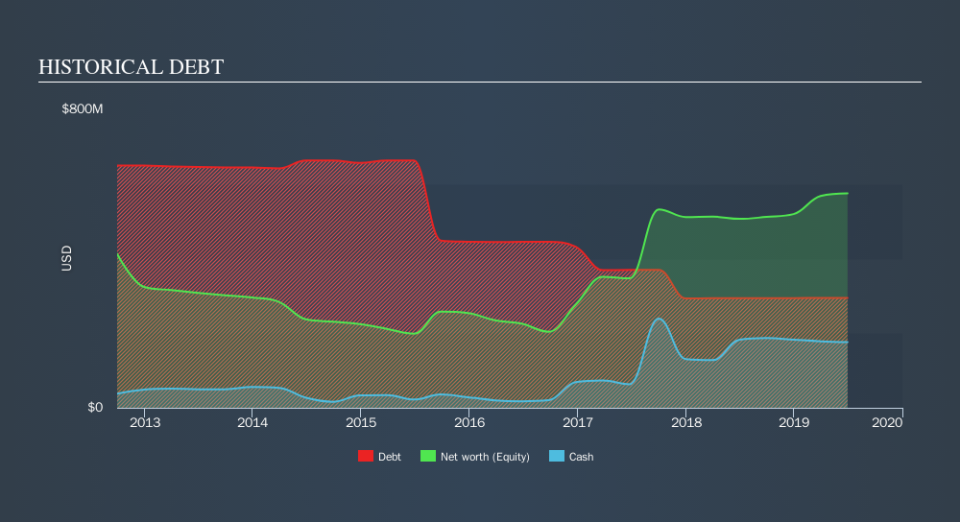These 4 Measures Indicate That Kratos Defense & Security Solutions (NASDAQ:KTOS) Is Using Debt Reasonably Well

Legendary fund manager Li Lu (who Charlie Munger backed) once said, 'The biggest investment risk is not the volatility of prices, but whether you will suffer a permanent loss of capital. So it seems the smart money knows that debt - which is usually involved in bankruptcies - is a very important factor, when you assess how risky a company is. As with many other companies Kratos Defense & Security Solutions, Inc. (NASDAQ:KTOS) makes use of debt. But the real question is whether this debt is making the company risky.
When Is Debt Dangerous?
Debt and other liabilities become risky for a business when it cannot easily fulfill those obligations, either with free cash flow or by raising capital at an attractive price. If things get really bad, the lenders can take control of the business. However, a more usual (but still expensive) situation is where a company must dilute shareholders at a cheap share price simply to get debt under control. Of course, the upside of debt is that it often represents cheap capital, especially when it replaces dilution in a company with the ability to reinvest at high rates of return. The first thing to do when considering how much debt a business uses is to look at its cash and debt together.
View our latest analysis for Kratos Defense & Security Solutions
What Is Kratos Defense & Security Solutions's Net Debt?
The chart below, which you can click on for greater detail, shows that Kratos Defense & Security Solutions had US$294.6m in debt in June 2019; about the same as the year before. On the flip side, it has US$176.2m in cash leading to net debt of about US$118.4m.
How Healthy Is Kratos Defense & Security Solutions's Balance Sheet?
We can see from the most recent balance sheet that Kratos Defense & Security Solutions had liabilities of US$188.9m falling due within a year, and liabilities of US$409.8m due beyond that. Offsetting these obligations, it had cash of US$176.2m as well as receivables valued at US$236.9m due within 12 months. So it has liabilities totalling US$185.6m more than its cash and near-term receivables, combined.
Of course, Kratos Defense & Security Solutions has a market capitalization of US$2.18b, so these liabilities are probably manageable. But there are sufficient liabilities that we would certainly recommend shareholders continue to monitor the balance sheet, going forward.
We use two main ratios to inform us about debt levels relative to earnings. The first is net debt divided by earnings before interest, tax, depreciation, and amortization (EBITDA), while the second is how many times its earnings before interest and tax (EBIT) covers its interest expense (or its interest cover, for short). The advantage of this approach is that we take into account both the absolute quantum of debt (with net debt to EBITDA) and the actual interest expenses associated with that debt (with its interest cover ratio).
Even though Kratos Defense & Security Solutions's debt is only 2.0, its interest cover is really very low at 2.0. This does have us wondering if the company pays high interest because it is considered risky. Either way there's no doubt the stock is using meaningful leverage. It is well worth noting that Kratos Defense & Security Solutions's EBIT shot up like bamboo after rain, gaining 83% in the last twelve months. That'll make it easier to manage its debt. The balance sheet is clearly the area to focus on when you are analysing debt. But it is future earnings, more than anything, that will determine Kratos Defense & Security Solutions's ability to maintain a healthy balance sheet going forward. So if you're focused on the future you can check out this free report showing analyst profit forecasts.
Finally, while the tax-man may adore accounting profits, lenders only accept cold hard cash. So we clearly need to look at whether that EBIT is leading to corresponding free cash flow. During the last two years, Kratos Defense & Security Solutions burned a lot of cash. While investors are no doubt expecting a reversal of that situation in due course, it clearly does mean its use of debt is more risky.
Our View
Kratos Defense & Security Solutions's conversion of EBIT to free cash flow was a real negative on this analysis, as was its interest cover. But its EBIT growth rate was significantly redeeming. When we consider all the factors mentioned above, we do feel a bit cautious about Kratos Defense & Security Solutions's use of debt. While we appreciate debt can enhance returns on equity, we'd suggest that shareholders keep close watch on its debt levels, lest they increase. We'd be motivated to research the stock further if we found out that Kratos Defense & Security Solutions insiders have bought shares recently. If you would too, then you're in luck, since today we're sharing our list of reported insider transactions for free.
If, after all that, you're more interested in a fast growing company with a rock-solid balance sheet, then check out our list of net cash growth stocks without delay.
We aim to bring you long-term focused research analysis driven by fundamental data. Note that our analysis may not factor in the latest price-sensitive company announcements or qualitative material.
If you spot an error that warrants correction, please contact the editor at editorial-team@simplywallst.com. This article by Simply Wall St is general in nature. It does not constitute a recommendation to buy or sell any stock, and does not take account of your objectives, or your financial situation. Simply Wall St has no position in the stocks mentioned. Thank you for reading.

 Yahoo Finance
Yahoo Finance 
